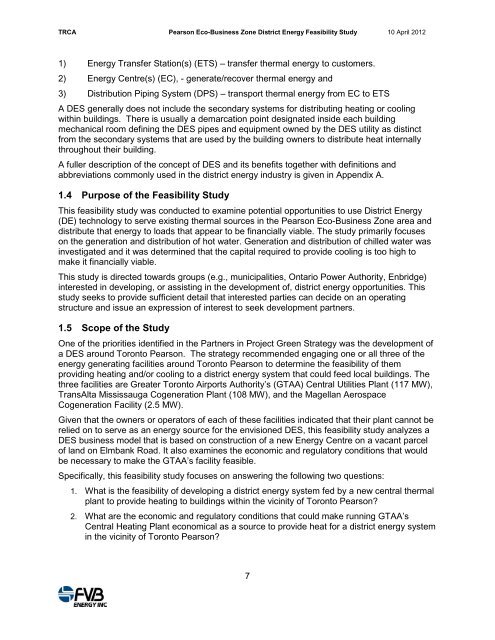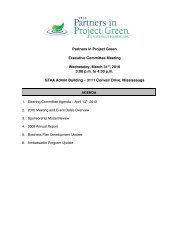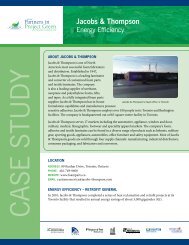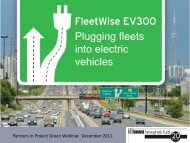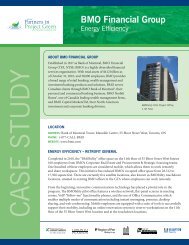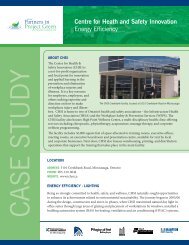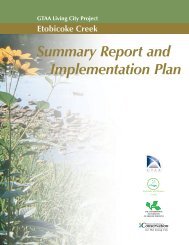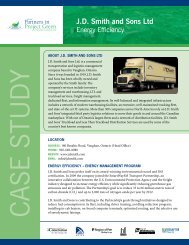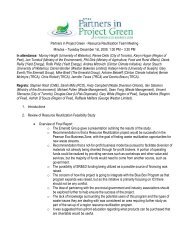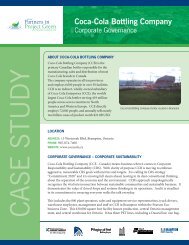Project Green District Energy Feasibility Study - Partners in Project ...
Project Green District Energy Feasibility Study - Partners in Project ...
Project Green District Energy Feasibility Study - Partners in Project ...
Create successful ePaper yourself
Turn your PDF publications into a flip-book with our unique Google optimized e-Paper software.
TRCA Pearson Eco-Bus<strong>in</strong>ess Zone <strong>District</strong> <strong>Energy</strong> <strong>Feasibility</strong> <strong>Study</strong> 10 April 2012<br />
1) <strong>Energy</strong> Transfer Station(s) (ETS) – transfer thermal energy to customers.<br />
2) <strong>Energy</strong> Centre(s) (EC), - generate/recover thermal energy and<br />
3) Distribution Pip<strong>in</strong>g System (DPS) – transport thermal energy from EC to ETS<br />
A DES generally does not <strong>in</strong>clude the secondary systems for distribut<strong>in</strong>g heat<strong>in</strong>g or cool<strong>in</strong>g<br />
with<strong>in</strong> build<strong>in</strong>gs. There is usually a demarcation po<strong>in</strong>t designated <strong>in</strong>side each build<strong>in</strong>g<br />
mechanical room def<strong>in</strong><strong>in</strong>g the DES pipes and equipment owned by the DES utility as dist<strong>in</strong>ct<br />
from the secondary systems that are used by the build<strong>in</strong>g owners to distribute heat <strong>in</strong>ternally<br />
throughout their build<strong>in</strong>g.<br />
A fuller description of the concept of DES and its benefits together with def<strong>in</strong>itions and<br />
abbreviations commonly used <strong>in</strong> the district energy <strong>in</strong>dustry is given <strong>in</strong> Appendix A.<br />
1.4 Purpose of the <strong>Feasibility</strong> <strong>Study</strong><br />
This feasibility study was conducted to exam<strong>in</strong>e potential opportunities to use <strong>District</strong> <strong>Energy</strong><br />
(DE) technology to serve exist<strong>in</strong>g thermal sources <strong>in</strong> the Pearson Eco-Bus<strong>in</strong>ess Zone area and<br />
distribute that energy to loads that appear to be f<strong>in</strong>ancially viable. The study primarily focuses<br />
on the generation and distribution of hot water. Generation and distribution of chilled water was<br />
<strong>in</strong>vestigated and it was determ<strong>in</strong>ed that the capital required to provide cool<strong>in</strong>g is too high to<br />
make it f<strong>in</strong>ancially viable.<br />
This study is directed towards groups (e.g., municipalities, Ontario Power Authority, Enbridge)<br />
<strong>in</strong>terested <strong>in</strong> develop<strong>in</strong>g, or assist<strong>in</strong>g <strong>in</strong> the development of, district energy opportunities. This<br />
study seeks to provide sufficient detail that <strong>in</strong>terested parties can decide on an operat<strong>in</strong>g<br />
structure and issue an expression of <strong>in</strong>terest to seek development partners.<br />
1.5 Scope of the <strong>Study</strong><br />
One of the priorities identified <strong>in</strong> the <strong>Partners</strong> <strong>in</strong> <strong>Project</strong> <strong>Green</strong> Strategy was the development of<br />
a DES around Toronto Pearson. The strategy recommended engag<strong>in</strong>g one or all three of the<br />
energy generat<strong>in</strong>g facilities around Toronto Pearson to determ<strong>in</strong>e the feasibility of them<br />
provid<strong>in</strong>g heat<strong>in</strong>g and/or cool<strong>in</strong>g to a district energy system that could feed local build<strong>in</strong>gs. The<br />
three facilities are Greater Toronto Airports Authority’s (GTAA) Central Utilities Plant (117 MW),<br />
TransAlta Mississauga Cogeneration Plant (108 MW), and the Magellan Aerospace<br />
Cogeneration Facility (2.5 MW).<br />
Given that the owners or operators of each of these facilities <strong>in</strong>dicated that their plant cannot be<br />
relied on to serve as an energy source for the envisioned DES, this feasibility study analyzes a<br />
DES bus<strong>in</strong>ess model that is based on construction of a new <strong>Energy</strong> Centre on a vacant parcel<br />
of land on Elmbank Road. It also exam<strong>in</strong>es the economic and regulatory conditions that would<br />
be necessary to make the GTAA’s facility feasible.<br />
Specifically, this feasibility study focuses on answer<strong>in</strong>g the follow<strong>in</strong>g two questions:<br />
1. What is the feasibility of develop<strong>in</strong>g a district energy system fed by a new central thermal<br />
plant to provide heat<strong>in</strong>g to build<strong>in</strong>gs with<strong>in</strong> the vic<strong>in</strong>ity of Toronto Pearson?<br />
2. What are the economic and regulatory conditions that could make runn<strong>in</strong>g GTAA’s<br />
Central Heat<strong>in</strong>g Plant economical as a source to provide heat for a district energy system<br />
<strong>in</strong> the vic<strong>in</strong>ity of Toronto Pearson?<br />
7


